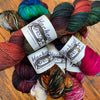Ah, blocking. Like doing gauge swatches it is often a step that is skipped. (But shouldn't be!)
We have tackled the subject of blocking before, focusing on when we think blocking is necessary and how to quickly wash a hat using a Stasher bag, but this time we are getting specific. We are talking one particular tool that can make blocking certain things a million times easier- blocking wires.
What Are Blocking Wires?
 It's really all in the name- they are long metal wires used to block finished projects. They usually come in thinner (lace weight) and thicker (worsted weight) sizes, but the conclusion most of the Twistedistas have come to is that either size works for most projects just fine. If you prefer to do actual laceweight projects, you might want those skinner wires but, otherwise, we find the slightly more robust worsted weight wires hold their shape better and are easier to work with.
It's really all in the name- they are long metal wires used to block finished projects. They usually come in thinner (lace weight) and thicker (worsted weight) sizes, but the conclusion most of the Twistedistas have come to is that either size works for most projects just fine. If you prefer to do actual laceweight projects, you might want those skinner wires but, otherwise, we find the slightly more robust worsted weight wires hold their shape better and are easier to work with.
When To Use Them
Lace shawls and wraps are the classic applications for blocking wires. But blankets and other items with a specific, geometric shape and very straight edges also benefit from blocking with wires.
Whether or not to use wires also depends on how complicated the stitchwork is in the project. Lacework, beading, and cables all benefit greatly from blocking, and, for a project like a shawl with distinct straight edges, wires can be a godsend. Check out this series of pictures to see a before and after of what blocking and blocking wires specifically can do AND what it looks like when you use just t-pins...



How They Work
Think of blocking wires as one long continuous line that you thread through the edges of your finished project. One or two wires per edge (depending on how long it is) will usually do the trick. Most blocking wire sets come with 10-12 wires so the chances of running out are slim.
You will still want to use t-pins to keep the wires tacked down to your blocking mat, but not nearly as many as you would need for, say, a whole shawl on its own. Your wire to t-pin ratio comes down to how many t-pins you own, how big your project is, and how much detail you want to call out in the design.
 Why They Work
Why They Work
Wires help you achieve a straighter more consistent edge than t-pins alone for several reasons. First, it's inherently a straight line instead of many points - done correctly it will by its nature help pull an edge straight or picots to the same length.
Second, inserting two wires is so much easier and faster than dozens and dozens of pins that you're likely to do a better job of it...
Also, wires can be extra handy if you don't have an area that is quite large enough to pin down your whole project. Wires force the edge to stay put relative to itself even if something is cantilevered off the edge of a table.
The Takeaway
So, should you invest in blocking wires? The answer, as so often: it depends. Mostly it depends on what you like to make. Shawls? Lace? Beaded projects? Complicated stitchwork? If you answered yes, then chances are they will make your life easier!







